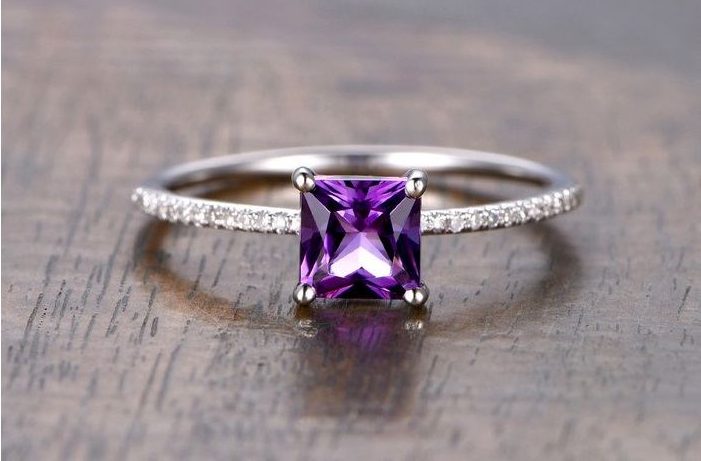The amethyst necklace, with its enchanting purple hues and mystical aura, has always been a popular choice among jewelry enthusiasts. However, when purchasing an amethyst necklace, it is crucial to consider its cost performance to ensure that you are getting the best value for your money. This article aims to provide a detailed, logical, and popular science-style guide on how to judge the cost performance of an amethyst necklace from a professional jewelry appraiser’s perspective.
Understanding the Basics of Amethyst
Before diving into the specifics of cost performance, it is essential to have a foundational understanding of amethyst. Amethyst is a variety of quartz that exhibits a striking purple color due to trace amounts of iron and aluminum impurities within its crystalline structure. This gemstone is known for its hardness, durability, and beautiful coloration, making it a popular choice for jewelry.
Evaluating the Quality of Amethyst
The quality of an amethyst necklace is a key factor in determining its cost performance. High-quality amethyst will generally have a higher cost performance ratio than lower-quality stones. Here are some key aspects to consider when evaluating the quality of amethyst:
Color
Color is one of the most critical factors in determining the quality and, consequently, the cost performance of amethyst. Ideally, amethyst should have a deep, even purple hue with minimal color zoning or variations. The richer and more vivid the purple, the higher the quality and, typically, the better the cost performance. However, personal preference should also be considered as some people may prefer lighter lavender hues.
Clarity
Clarity refers to the internal and external flaws within the amethyst. High-clarity amethyst will have fewer inclusions, cracks, or surface imperfections, enhancing its overall appearance and, thus, its cost performance. It is important to note that some inclusions can add character and uniqueness to a gemstone, but they should not detract from its overall beauty.
Cut
The cut of an amethyst can significantly impact its brilliance, sparkle, and overall appearance. A well-cut amethyst will have smooth, symmetrical facets that maximize its light-reflecting properties. Poorly cut stones may appear dull or lackluster, reducing their cost performance.
Carat Weight
The size and weight of an amethyst also play a role in its cost performance. Larger stones are generally more rare and, therefore, more valuable. However, it is important to consider the overall quality in relation to the size to ensure that the cost performance remains favorable.
Assessing the Craftsmanship of the Necklace
In addition to the quality of the amethyst itself, the craftsmanship of the necklace is another critical factor in determining its cost performance. Here are some aspects to consider:
Metal Type
The type of metal used in the necklace can affect its durability, comfort, and overall appearance. Higher-quality metals such as gold or platinum will generally have a higher cost but may offer better durability and a more luxurious feel, enhancing the cost performance.
Design and Setting
The design and setting of the necklace can also impact its cost performance. Intricate designs and high-quality settings can add to the overall value of the piece, but they should also be balanced with the quality of the amethyst to ensure a favorable cost-performance ratio.
Market Considerations
When assessing the cost performance of an amethyst necklace, it is essential to consider the current market trends and conditions. Here are some key market considerations:
Supply and Demand
The supply and demand for amethyst can affect its pricing and, consequently, its cost performance. If the supply is low and the demand is high, prices may be inflated, reducing the cost performance. Conversely, if the supply is high and the demand is low, prices may be more favorable, enhancing the cost performance.
Geographic Location
The geographic location of the amethyst’s origin can also impact its pricing and cost performance. Some regions may have a reputation for producing higher-quality amethyst, which can drive up prices. However, it is important to research and compare prices from different origins to find the best cost performance.
Economic Conditions
Overall economic conditions can also affect the pricing of amethyst necklaces. During times of economic uncertainty, consumers may be more budget-conscious, which can lead to lower prices and better cost performance for amethyst necklaces.
Conclusion
udging the cost performance of an amethyst necklace involves considering multiple factors, including the quality of the amethyst, the craftsmanship of the necklace, and current market conditions. By carefully evaluating these factors, you can make an informed decision and ensure that you are getting the best value for your money. Remember, the key to finding a high-cost performance amethyst necklace is to strike a balance between quality, design, and affordability.
Related topic:
- What Kind of Energy Reaction Will Amethyst Produce When Placed…
- The Relationship between Amethyst and Hematite in Terms of Crystal…
- Amethyst and Opal: A Wonderful Encounter of Energy Complementarity


